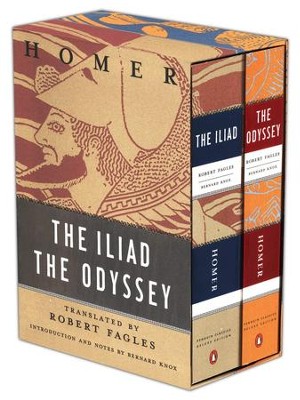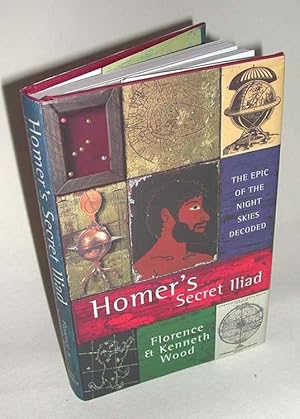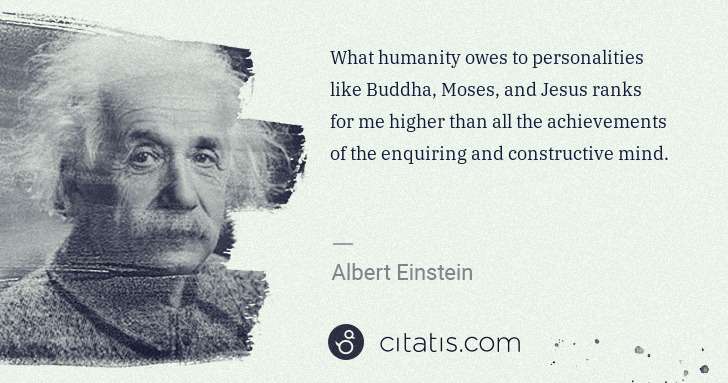
by
Damien F. Mackey
Scholars variously find
Homer’s classics to be replete with astronomical detail,
or bursting with biblical
allusions, or serving as accurate navigational guides.
Perhaps they encompass all
of this and more.
I must
admit to having been completely enthralled by Florence and
Kenneth Wood’s:
Homer's
Secret Iliad
The Epic of the Nights Skies
Decoded.

According
to one review of this book:
Not New Age Kookery
Homer's Secret Iliad is rich in the elaboration of its
hypotheses, such as its discussion of the gods and goddesses as planets, able
to wander throughout the ecliptic band of the skies and, thus, influence the
fate of the mortals, who are the fixed stars, and hence fixed in their actions.
The book provides dozens of examples to bolster each of its arguments, which
are extensive. Florence and Kenneth Wood spent years, following the death of
Edna Leigh in 1991, working through her hypothesis, and fitting [hundreds] ….
of examples into the architecture which Leigh had created.
In the introduction to the book, Kenneth Wood describes the cold
reception received by himself and his wife, when they presented their analysis
to establishment academia. Fortunately, they came in contact with serious
scholars, such as Giorgio de Santillana and Hertha von Deschend, authors of the
1983 Hamlet's Mill, who are themselves investigating how the knowledge
of precession shaped ancient civilizations; their studies have already pushed
the calendar of civilization much farther back than the oligarchy would like.
Work of this sort is very different
from the school of outright New Age kooks, who have many popular books
currently in circulation, which present the evidence of ancient societies'
knowledge of precession and astronomy, as magical, mysterious, or even coming
from aliens from outer space. (One might call this the "Edgar Cayce"
school of history, after the agent who claimed that his knowledge of the
extreme antiquity of Egypt came from his ability to "channel" the
knowledge directly from ancient Egyptians.) Instead, Homer's Secret Iliad
joins the growing list of serious contributions in many disciplines piling up
each year, which demonstrate that mankind has advanced, through his powers of
cognition and discovery, throughout tens of millennium--rather than stumbling
from one cultish civilization to the next over the last 2,500 years. ….
[End of quote]
One
ought to acquire and read this terrific book.
My own
little contribution has been of a biblical nature, regarding mainly The Odyssey:
this
fortuitous apparent connection (Job and Tobit) seeming also to support my view
that the prophet Job was Tobias, son of Tobit. See e.g. my article:
Job's Life and Times
Much
earlier:
St Jerome saw resemblance
of Tobit to Homer's 'The Odyssey'
Felice
Vinci (in Athens
Journal of Mediterranean Studies -
Volume 3, Issue 2 – Pages 163-186) has, for his part, argued
for:
The Nordic Origins
of the Iliad and Odyssey: An Up-to-date Survey of the Theory
The Northern Features of
Homer’s World
Northern Features of
Climate, Clothes, Food, and Vessels
Homer’s world presents northern
features. The climate is normally cold and unsettled, very different from what
we expect in the traditional Mediterranean setting. The Iliad dwells
upon violent storms (i.e., in Il. IV: 275-278, XI: 305-308, XIII: 795-799),
torrential rain and disastrous floods (Il. V: 87-91, XI: 492-495, XIII: 37-141,
XVI: 384-388), and often mentions snow (Il. XII, 156-158), even on lowlands (Il.
XII: 278-286, X: 6-8, XV: 170-171; XIX: 357-358, III: 222). Fog is found
everywhere, e.g., in the "misty sea" (Od. V, 281), and also in Troy
(Il. XVII: 368), Scherie (Od. VII, 41-42), Ithaca (Od. XIII: 189), the
Cyclopes’ land (Od. IX: 144), and so on.
As regards the sun, the Iliad hardly
ever refers to its heat or rays; the Odyssey never mentions the sun
warmth in Ithaca, though it refers to the sailing season. As to the seasons,
there is a parallel between Homer, who mentions only three seasons: winter,
spring and summer, and Tacitus’s Germans, for whom "winter, spring and
summer have meaning and names, but they are unaware of the name and produce of
autumn" (Germania, 26: 4). Vol. 3, No. 2 Vinci: The Nordic
Origins of the Iliad and Odyssey... Clothes described
in the two poems are consistent with a northern climate and the finds of the
Nordic Bronze age. In the episode of the Odyssey in which Telemachus and
Peisistratus are guests at Menelaus’s house in Sparta, the two young men get
ready for lunch after a bath: "They wore thick cloaks and tunics"
(Od. IV: 50–51). The same is said of Odysseus when he is a guest at Alcinous’s
house (Od. VIII: 455-457). Similarly, Nestor’s cloak is "double and large;
a thick fur stuck out" (Il. X: 134) and, when Achilles leaves for Troy,
his mother thoughtfully prepares him a trunk "filled with tunics,
wind-proof thick cloaks and blankets" (Il. XVI: 223-224). Those
"thick cloaks and tunics" can be compared to the clothes of a man
found in a Danish Bronze Age tomb: "The woolen tunic comes down to the
knees and a belt ties it at the waist. He also wears a cloak, which a bronze
buckle pins on his shoulder" (Bibby 1966: 245). Also Odysseus wears
"a golden buckle" (Od. XIX: 226) on his cloak, and "a shining
tunic around his body like the peel on a dry onion" (Od. XIX: 232-233);
all of this fit what Tacitus says of Germanic clothes: "The suit for
everyone is a cape with a buckle (…) The richest are distinguished by a suit
(...) which is close-fitting and tight around each limb" (Germania 17:
1).
Regarding food,
it’s remarkable that fruit, vegetables, olive oil, olives, figs never appear on
the table of Homer’s heroes. Their diet was based on meat (beef, pork, goat,
and game), much like that of the Vikings, who "ate meat in large
quantities, so much so that they seemed to regard the pleasure of eating meat
as one of the joys of life" (Pörtner 1996: 207). Homer’s characters had a
hearty meal in the morning: "In the hut Odysseus and his faithful
swineherd lit the fire and prepared a meal at sunrise" (Od. XVI: 1–2),
like Tacitus’s Germans: "As soon as they wake up (…) they eat; everyone
has his own chair and table" (Germania 22: 1). This individual
table (trapeza) is typical of the Homeric world, too (Od. I: 138).
One should also
note that, while pottery tableware was prevalent in Greece, the Nordic world
was marked by "a stable and highly advanced bronze founding industry"
(Fischer-Fabian 1985: 90), which squares with Homer’s poems, which mention only
vessels made of metal: "A maid came to pour water from a beautiful golden
jug into a silver basin" (Od. I, 136-137); wine was poured "into gold
goblets" (III: 472) and "gold glasses" (I: 142). When a vessel
felt to the ground in Odysseus’ palace, instead of breaking it
"boomed" (bombēse, Od. XVIII: 397). Also lamps (XIX: 34),
cruets (VI: 79), and urns (Il. XXIII: 253) were made of gold. As to the poor,
Eumaeus the herdsman pours wine for his guests "into a wooden cup" (kissybion,
Od. XVI: 52), like the cup Odysseus gives Polyphemus (Od. IX: 346). Wood, of
course, is the cheapest material in the north (Estonia and Latvia have an
ancient tradition of wooden beer tankards). Athens Journal of Mediterranean
Studies April 2017
Nordic
Customs and Archaism of Homer’s World
There are many
remarkable parallels between the Homeric Achaeans and the Nordic world, in the
fields of their social relations, interests, lifestyles, and so on, despite the
time gap.
E.g., Homer’s
habit of giving things and slaves a value in "oxen" – a new vase, decorated
with flowers, was worth "the price of an ox" (Il. XXIII, 885); a big
tripod was worth twelve oxen (Il. XXIII: 703); Ulysses’ nurse Eurycleia had
cost twenty oxen (Od. I: 431), and so on – is comparable to the fact that,
during the first Viking Age, cows were still used "as the current monetary
unit" (Pörtner 1996: 199). A statement from Tacitus bridges these two
distant epochs: "Cattle and oxen (...) are the Germans’ only and highly
valued wealth" (Germania, 5, 1). Besides, the prominence of oxen in
the economy of the Homeric world is another argument in favour of the Nordic
setting, while in the Greek world other kinds of livestock are more important
(one should also consider how important were beef and pork in Achaeans’ diet).
Still on Tacitus,
Karol Modzelewski, by quoting a custom reported in Germania, 11, writes:
"The mention of assembly decisions taken by a peculiar acclamation method,
consisting in brandishing spears, is confirmed by the codifications, dating
back to the 12th century, of the Norwegian juridical traditions, where this
rite is called vapnaták" (Modzelewski 2008: 33). It is remarkable
that the custom of going armed with spear to the assembly is found in Homer:
Telemachus "went to the assembly, he held the bronze spear" (Od. II:
10). Thus a custom dating back to the Homeric world was still present in Viking
Norway of the 12th century.
One should also
note that Odysseus’ ship had a removable mast, a feature typical of all Homeric
vessels: both the Iliad (I: 434, 480) and Odyssey (II: 424, VIII:
52) confirm that setting up and taking down the mast were customary at the
beginning and the end of each mission. This feature was also typical of the
Viking ships, which lowered the mast whenever there was the risk of sudden
gusts or ice formation, which could cause the ship to capsize. Another
structural feature typical of Viking ships, the flat keel, is found also in
Homeric ones, as one can infer from the passage narrating Ulysses’ arrival in
Ithaca, where the Phaeacian ship "mounted the beach by half the
length" (Od. XIII: 114).
Another peculiar
custom of the Homeric heroes is that they got off the chariots and left them
aside during the duels: e.g., the Trojan hero Asius used to fight "on foot
in front of his puffing horses, which the charioteer kept all the time behind
him" (Il. XIII: 385–386). Scholars agree that this way of using the
chariots seems to be absurd and senseless: "No one has ever fought like
the heroes of Homer. They are led to battle in chariot, then they jump off to
fight against the enemy. All that we know about the battle chariots in Eastern
Mediterranean protests against this view of things" (Vidal-Naquet 2013:
573). However, what looks odd in the Mediterranean fits the Nordic world:
according to Diodorus of Sicily, the Celts "employed two-horse chariots,
each with his coachman and warrior, and, when they confronted each other in
war, Vol. 3, No. 2 Vinci: The Nordic Origins of the Iliad and Odyssey... they
used to throw the javelin, then they came down from the chariot and fought with
the sword" (Historical Library 5: 29). Still Diodorus writes that
"Brittany is said to be inhabited by native tribes conforming to their
ancient way of life. In war they use chariots, like the ancient Greek heroes in
the Trojan war" (Historical Library 5: 21). Julius Caesar adds
other details upon the Britains: "When they have worked themselves in
between the troops of horse, leap from their chariots and engage on foot. The
charioteers in the mean time withdraw some little distance from the battle, and
so place themselves with the chariots that, if their masters are overpowered by
the number of the enemy, they may have a ready retreat to their own troops.
Thus they display in battle the speed of horse, together with the firmness of
infantry" (De bello Gallico IV: 33).
So, the chariot
fightings narrated by the Iliad are not absurdities due to the supposed
ignorance of the poet; instead, Homer must be considered the only extraordinary
witness of the Nordic Bronze Age, whose archaic customs survived in Britain
until Caesar’s age.
This confirms what
Stuart Piggott writes: "The nobility of the [Homeric] hexameters should
not deceive us into thinking that the Iliad and the Odyssey are
other than the poems of a largely barbarian Bronze Age or Early Iron Age
Europe. There is no Minoan or Asiatic blood in the veins of the Grecian Muses
(...) They dwell remote from the Cretan-Mycenaean world and in touch with the
European elements of Greek speech and culture (...) Behind Mycenaean Greece
(...) lies Europe" (Piggott 1968: 126). Besides, according to Geoffrey
Kirk, the Homeric poems "were created (...) by a poet, or poets, who were
completely unaware of the techniques of writing," (Kirk 1989: 78) and
"a recent linguistic argument suggests that the Homeric tmesis, i.e. the
habit of separating adverbial and prepositional elements that were later
combined into compound verbs belongs to a stage of language anterior to that
represented in the Linear B tablets. If so, that would take elements of Homer’s
language back more than five hundred years before his time" (Kirk 1989:
88-89).
That’s
why "there is an absolute difference both in extension and quality between
the Mycenaean society and Iliad’s" (Codino 1974: IX): Homer’s
civilization appears more archaic than the Mycenaean one. There is also the odd
case of Dionysus, who is an important god both in the Mycenaean period and in
classical Greece, but is almost unknown in Homer: Homer’s world, therefore,
probably preceded the Mycenaean civilisation, instead of following it.
….

